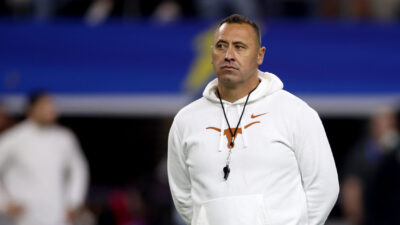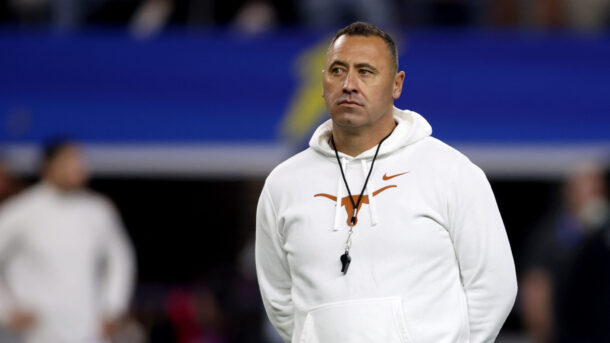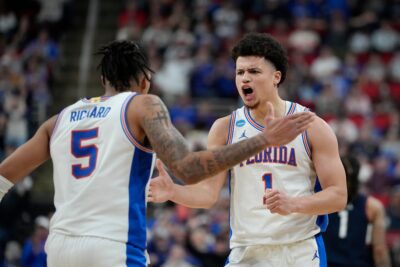Ad Disclosure
Bad teams don’t win national championships. Some champions, however, are better than others.
For every juggernaut such as Indiana in 1976 or several of John Wooden’s UCLA teams that ran the table during their school’s dynasty of the 1960s and early ’70s, there’s an unheralded underdog that came out of nowhere by catching fire at just the right time.
Here’s a look back at the 10 most unlikely of those March Madness winners.
They’re teams that might not have always looked like world-beaters but were at their best when it mattered most and will always be remembered as NCAA Tournament champions.
Worst March Madness Champions of All-Time
The criteria used to compile this subjective list include roster composition, NCAA Tournament seeding, number of losses and other extenuating circumstances. Consideration was also given to the era in which the teams played and the size of the Tournament field at the time. These are the 10 “worst” March Madness champions of all-time.
10. 1989 Michigan
The Wolverines started the season ranked No. 2 in the nation but suffered an early upset at the hands of Alaska-Anchorage and slipped to a 3-seed in the NCAA Tournament following a regular season in which they finished third in the Big Ten.
Their postseason prospects got even shakier a week before their first NCAA Tournament game when news broke that their coach, Bill Frieder, was planning to leave for Arizona State once the season was over. Frieder didn’t have to wait that long before heading to Tempe. When athletic director Bo Schembechler learned of his plans, he immediately fired Frieder and replaced him with assistant Steve Fisher.
Unlike the “Fab Five” teams that followed, this Michigan team wasn’t a star-studded unit beyond senior forward Glen Rice. But the coaching controversy seemed to galvanize the group. And they went on an incredible 6-game run that ended in triumph with an 80-79 overtime victory against Seton Hall in Seattle.
Rice was the driving force for the Wolverines on his way to setting an NCAA Tournament record with 184 points in wins against Xavier, South Alabama, North Carolina, Virginia, Illinois and Seton Hall. But it was point guard Rumeal Robinson who provided the most memorable moment of the season by hitting 2 free throws with 3 seconds remaining in the extra period after a controversial foul call by official John Clougherty.
9. 1981 Indiana
The Hoosiers were a championship favorite in 1980 until starters Randy Wittman and Mike Woodson went down with injuries. With the return of 3 starters, including Wittman and future Hall of Famer Isiah Thomas, expectations were high again in ’81.
But after starting the season ranked No. 4, Indiana fell out of the polls by going just 7-5 in its first dozen games, punctuated by back-to-back losses to Clemson and Texas-Pan American at the Rainbow Classic in Hawaii. The Hoosiers eventually got their act together and won the Big Ten. But their 9 losses are tied for the fourth-most of any champion in the NCAA Tournament, which began in 1939.
They were seeded No. 3 in the Mideast Region. But thanks to a rash of upsets, they didn’t have to face a team seeded higher than No. 6 on the Road to the Final Four in Philadelphia. There, they took down LSU, the top-seeded team in the West, before avenging a regular-season loss to North Carolina with a 63-50 victory in a championship game best remembered for nearly being postponed because of the assassination attempt on President Ronald Reagan.
8. 1997 Arizona
Only 5 of the 39 national champions that have been crowned since the Tournament field expanded to 64 teams in 1985 have been seeded lower than No. 3 in their Region. The Wildcats were the No. 4 seed in the Southeast Region after finishing fifth in the Pac-10 at 11-7 (19-9 overall).
Some of Arizona’s struggles were the result of an academic suspension that forced All-American guard Miles Simon to the sideline for the first 11 games. But even after he returned, Arizona never really hit its full stride. Lute Olson’s team stumbled into the postseason by going 4-4 in its final 8 games.
Once in March Madness, though, the light switch finally came on for Simon, Jason Terry, Mike Bibby and their teammates. The Wildcats knocked off three No. 1 seeds – Kansas in the Sweet 16, North Carolina in the Final Four and Kentucky in overtime in the final – on the way to their title.
Simon was named the Tournament’s Most Outstanding Player by scoring 24 against the Tar Heels before going off for 30, including 14-of-17 free throws, in the clinching victory against the Wildcats at the RCA Dome in Indianapolis.
7. 1983 NC State
The Cardiac Pack have taken on mythical proportions. And not just among NC State fans. They inspired the phrase “Survive and Advance,” which became the subject of ESPN’s popular “30 for 30” documentary and launched larger-than-life coach Jim Valvano to legendary status.
Like any great epic, the tale surrounding the 1983 champions has grown taller as the years have gone by. While it was an improbable achievement, especially the way it unfolded, it wasn’t quite the Cinderella story it’s now made out to be.
That team started the season ranked in the top 20 and was 7-2 when shooting guard Dereck Whittenburg, arguably its best player, suffered a broken foot that sidelined him for the next 17 games. The Wolfpack weren’t at full strength again until Whittenburg returned for the start of the ACC Tournament. Whether they had to win the ACC Tournament to get an NCAA bid in the 48-team field is a debate that can never truly be settled.
Either way, State ran through a gauntlet of elite teams and Hall of Fame opponents – Ralph Sampson, Michael Jordan and Hakeem Olajuwon among them – to reel off 9 consecutive wins and cut down the nets in Albuquerque, New Mexico as national champions. The final 54-52 win against heavily favored Houston, secured on Lorenzo Charles’ dramatic last-second dunk of a Whittenburg air ball, is still considered one of the top 2 upsets in NCAA Tournament history.
6. 1977 Marquette
Al McGuire’s Warriors were in serious jeopardy of not getting into the NCAA Tournament after dropping consecutive games to DePaul, Detroit and Wichita State in mid-February. But in a sign of just how much March Madness has changed since then, they learned they had been chosen into the 32-team field at halftime of their regular-season finale against Michigan. A game they also lost to fall to 20-7.
No team had ever won a national title with as many as 7 losses at that time. But that didn’t matter to McGuire and his crew. They’d already broken with convention with their stylish, untucked uniforms – designed by star forward Bo Ellis – and their controversial, outspoken coach who would later become one of his sport’s highest-profile broadcasters.
The Warriors had their share of close calls on the way to their championship. They survived the second round with a 1-point win against Kansas State behind a 26-point performance by point guard Butch Lee, then outlasted upstart UNC-Charlotte in the Final Four semifinals 51-49 on a full-court pass that resulted in a buzzer-beating layup by big man Jerome Whitehead.
Two nights later at The Omni in Atlanta, Marquette’s magical run appeared to have finally run out of steam against North Carolina after the Tar Heels erased an 8-point second half deficit. Immediately after taking their first lead since the opening minutes of the game, Dean Smith instructed the Tar Heels to go into their revered Four Corners offense. But instead of putting the game away, it shifted the momentum to the Warriors, who pulled away for a 67-59 that left their retiring coach in tears on the bench as time expired.
5. 1988 Kansas
The 1980s was a decade of upset champions. And perhaps no team epitomized the trend more than the 1988 Jayhawks. Even their nickname of “Danny and the Miracles,” inspired by star big man Danny Manning speaks to the unlikely nature of their postseason run.
Coached by vagabond Larry Brown, who left immediately after the season to join the NBA’s San Antonio Spurs, Kansas appeared to be down and out after starting the season 12-8 (1-4 in the old Big 8). But with Manning raising his game to a level that would earn him National Player of the Year honors, the unranked Jayhawks won 15 of their final 18 games, including 6 straight in the NCAA Tournament to take home the title as a No. 6 seed.
While Kansas did get the benefit of some bracket luck in the NCAA Tournament, facing lower-seeded teams in each of its first 3 games, its final 3 wins – against bitter in-state rival Kansas State, Duke and Oklahoma – were all against teams that had beaten the Jayhawks during the regular season.
In the championship game against the Sooners, played close to home at Kansas City’s Kemper Arena, Manning willed his team to victory by putting on a 1-man show. The senior big man, who would become the No. 1 overall pick in the NBA Draft, scored 31 points and pulled down 17 rebounds before clinching the 83-79 victory with a pair of free throws with 5 seconds remaining.
4. 1958 Kentucky
Not even legendary coach Adolph Rupp thought his Wildcats were of championship caliber when the season began. “We’ve got fiddlers, that’s all,” he was quoted as saying. “They’re pretty good fiddlers. Be right entertaining at a barn dance. But you need violinists to play at Carnegie Hall. We don’t have any violinists.”
For most of the regular season, it appeared as if The Baron was right. Kentucky lost 6 games. But because only 2 of them were against SEC opponents, they were able to get into the NCAA Tournament. Once on the big stage, the “Fiddlin’ Five” – as they became known – put on a virtuoso performance by winning Rupp’s fourth national title.
Led by All-American Adrian Smith and All-SEC teammate Vernon Hatton, the Wildcats survived a 1-point squeaker against Temple in the semifinals before cutting down the nets with an 84-72 win against Elgin Baylor and Seattle at Louisville’s Freedom Hall. The 6 losses were the most ever by an NCAA champion at the time – a record that stood for 19 years, after the NCAA Tournament was expanded.
3. 2014 UConn
The Huskies have hung 4 national championship banners and produced some of the best teams in college basketball history under Jim Calhoun and current coach Dan Hurley. The 2014 team coached by Kevin Ollie, isn’t among that group. Their national title was simply a case of a good team getting hot at the right time.
They didn’t look much like a title contender – much less an NCAA Tournament team – when they suffered an embarrassing 81-48 loss to Louisville in their final regular-season game. The 33-point defeat still is the largest suffered by an eventual national champion. But after reaching the final of the American Athletic Conference Tournament, where they lost to Louisville by a more respectable score of 71-61, they snuck into the NCAA field as the No. 7 seed in the East Region.
That’s where things suddenly began to click. One year after being banned from the Tournament for failing to meet minimum academic performance standards, UConn upset Villanova, Iowa State and Michigan State on the way to the Final Four before knocking off top overall seed Florida in the national semifinals. It then caught a break by meeting an even lower seed, No. 8 Kentucky, in the championship game.
With Tournament Most Outstanding Player Shabazz Napier scoring 22 points and pulling down 6 rebounds, the Huskies never trailed on the way to a 60-54 victory that made them the second-lowest seed ever to win a title and the only No. 7 seed to date to cut down the nets in March Madness.
2. 1985 Villanova
Two years after NC State’s improbable national championship, Rollie Massimino and his Villanova Wildcats upstaged the Wolfpack’s accomplishment by putting together an even more remarkable and unexpected title run.
The Wildcats were squarely on the NCAA bubble after going just 5-5 in their final 10 regular-season games and losing by 15 to St. John’s in the Big East Tournament semifinals to finish at 19-10. Even after getting into the field as an 8-seed, they barely scraped by winning their first 3 NCAA matchups – against Dayton, top-seeded Michigan and Maryland – by a combined total of 9 points.
They finally started building momentum with more comfortable victories against North Carolina in the Southeast Region final and Memphis in the Final Four before facing off against Big East rival Georgetown for the title at Rupp Arena in Lexington, Ky.
Commentators of the day suggested that it would take “the perfect game” for Villanova to pull off the biggest upset in NCAA final history by beating Patrick Ewing and the defending national champions. A team they lost to twice during the regular season. But that’s what they did. With Most Outstanding Player Ed Pinckney leading the way, the Wildcats shot 78.6% from the floor, the highest percentage in Final Four history, and scored on all but 1 of their second-half field goal attempts to stun the Hoyas 66-64.
1. 1939 Oregon
The Ducks won the first NCAA Tournament by beating Ohio State 46-33 behind a 15-point performance from John Dick. Although they were crowned national champions with a 29-5 record, it’s debatable whether they were the best team in college basketball.
Only 8 teams participated in the inaugural event. And because the National Invitation Tournament at New York’s Madison Square Garden was considered the more prestigious championship at the time, several top teams – including 23-0 LIU, 21-1 Loyola (Chicago) and 19-3 Bradley – turned down NCAA bids to play in it.
LIU beat Loyola 44-32 in the NIT final before 18,000 fans at Madison Square Garden to complete its undefeated season and stake its claim on the national title. The Oregon-Ohio State NCAA title game, by contrast, drew only about 5,000 fans in a 9,000-seat arena in Evanston, Ill.
Award-winning columnist Brett Friedlander has covered the ACC and college basketball since the 1980s.



